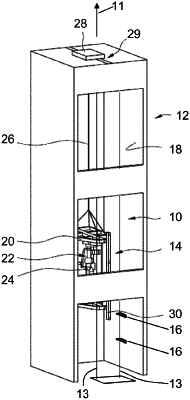| CPC G05B 19/402 (2013.01) [B23B 39/08 (2013.01); G05B 19/182 (2013.01); G05B 19/19 (2013.01); G05B 19/401 (2013.01)] | 15 Claims |

|
1. A method for automated determination of a drilling position of a drill hole for receiving a fastener for fastening a component to a possible wall area of a wall, the component including a contact surface and a through-opening, wherein, when the component is fastened to the wall, at least a part of the contact surface abuts against a support surface of the wall and the fastener is fixed in the drill hole and projects through the through-opening, wherein the possible wall area is flat and extends in a first direction and a second direction perpendicular to the first direction, and wherein a planned support surface with a planned drilling position area for the drill hole are preselected inside the possible wall area, the method comprising the following steps:
determining a first surface contour of the possible wall area;
examining the first surface contour and detecting any first irregularities in the first surface contour using a first detection rule;
determining a primary possible support surface area and a primary possible drilling position area for the drill hole that do not have any of the detected first irregularities;
examining a second surface contour of the primary possible drilling position area and detecting any second irregularities in the second surface contour using a second detection rule; and
determining a drilling position for the drill hole inside the primary possible drilling position area that does not have any of the detected second irregularities.
|